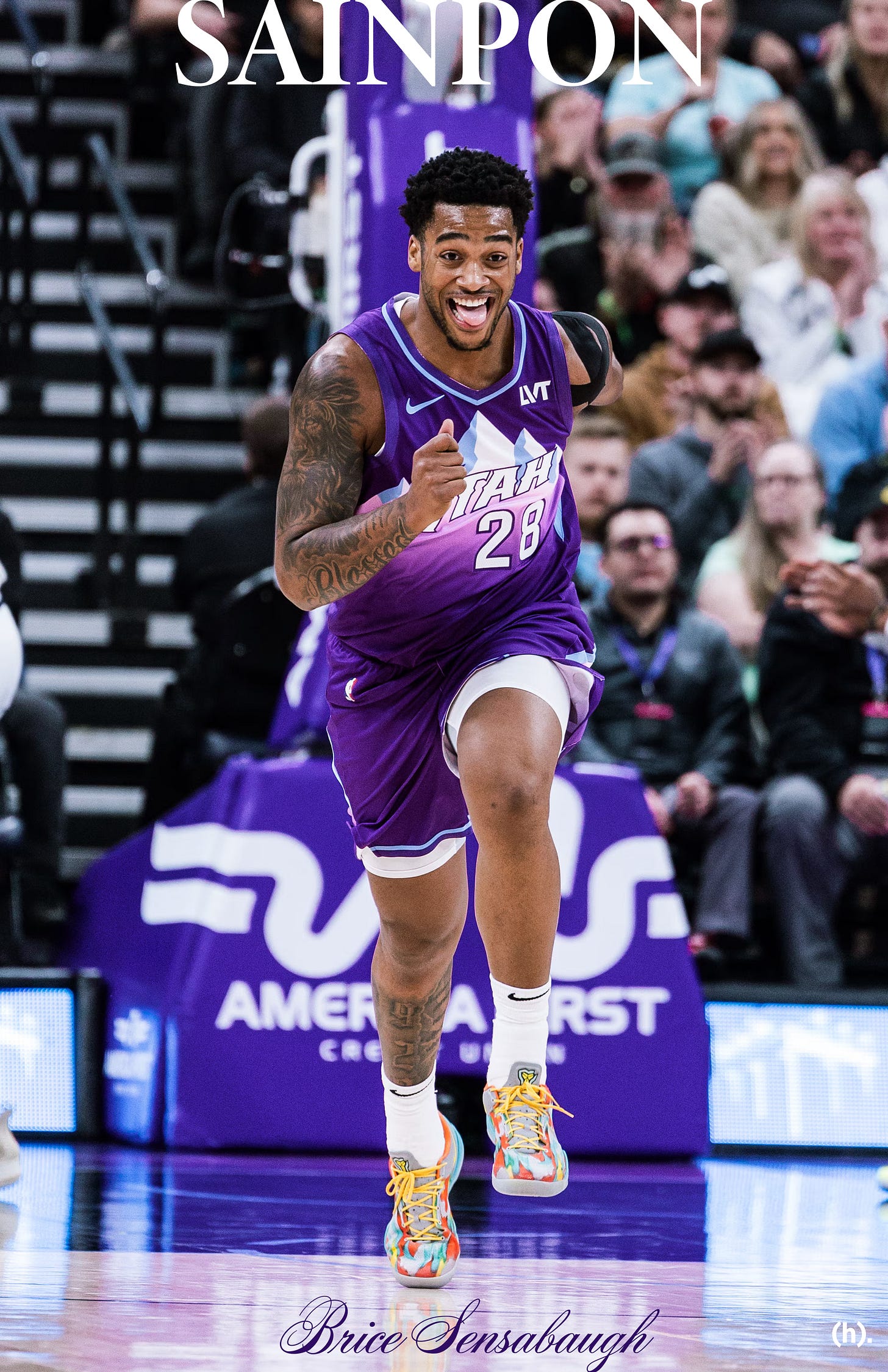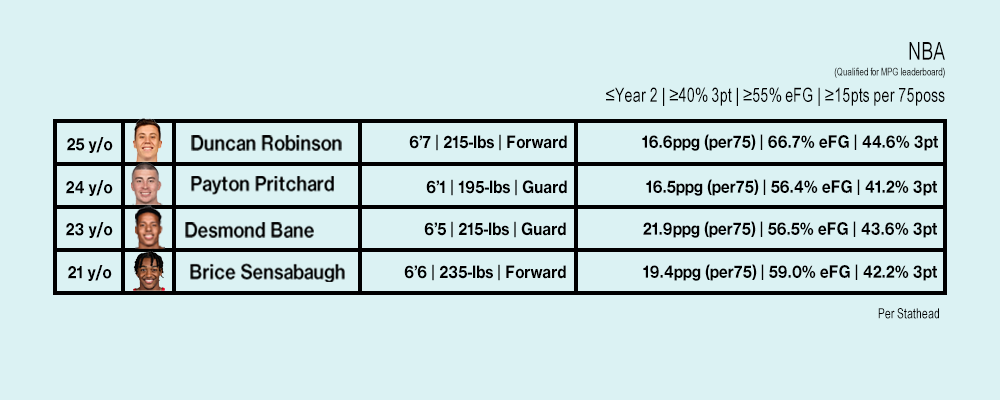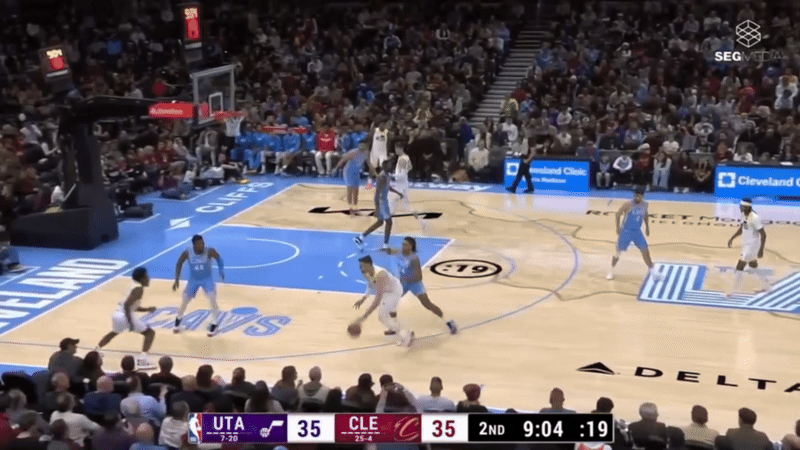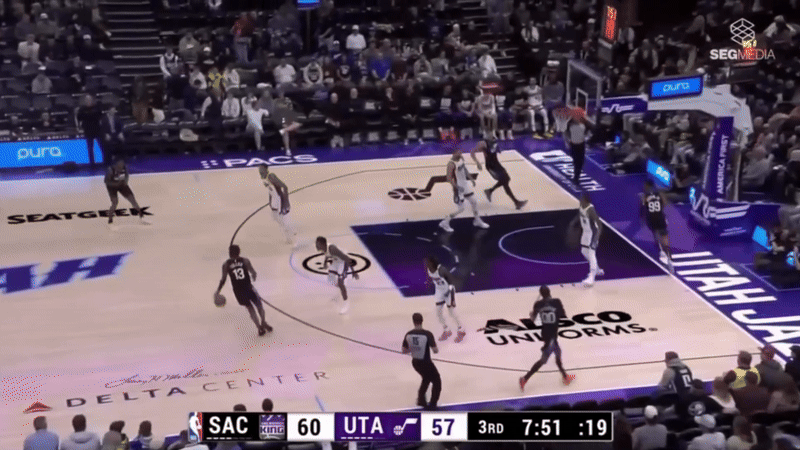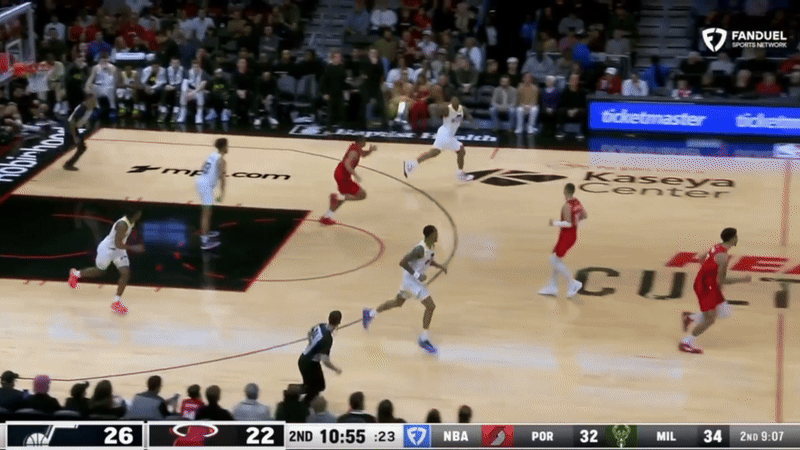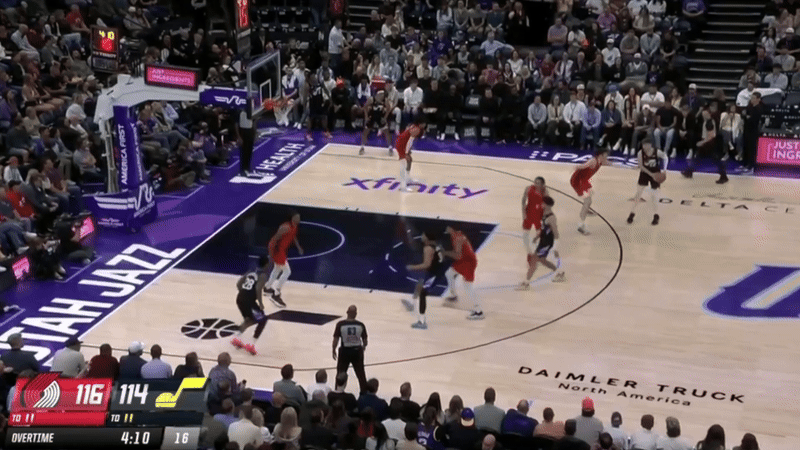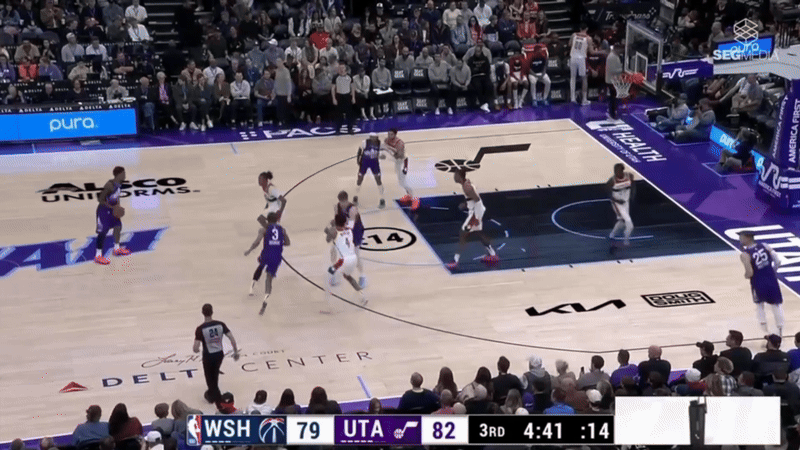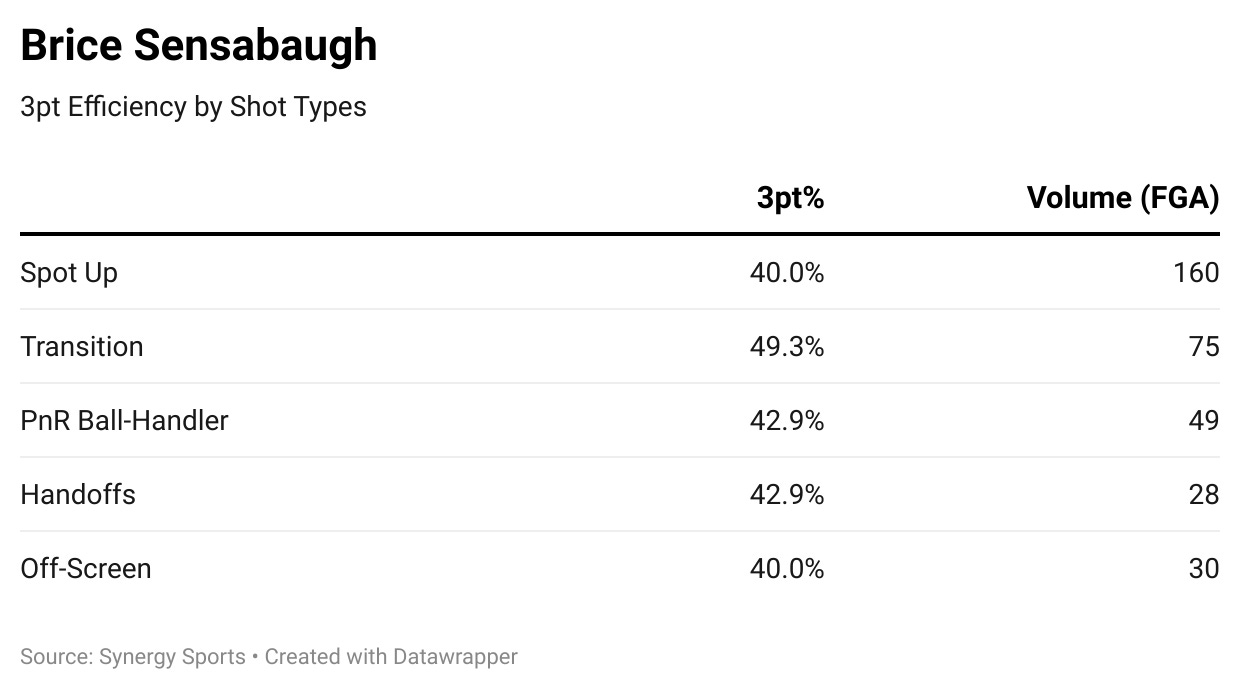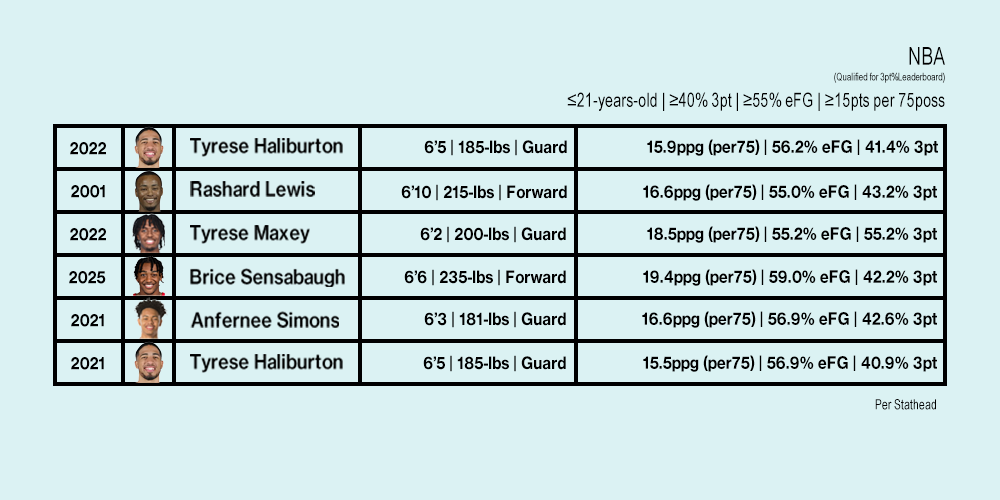Words on Brice Sensabaugh, Scouting, & Metrics.
As complex data analytics, player metrics, models, permeate through all facets of professional and amateur basketball, front office personnel and grassroot scouts alike have yet to formulate a resilient, back tested method of identifying talent to draft at pick value or better. The purpose of NBA metrics are straightforward—ranking player value by assigning a numerical value to production and/or impact. It illustrates the value of a player for one season, Value Over Replacement Player (VORP) for example, while fresher models amalgamates ones value across multiple concurrent seasons, Regularized Adjusted Plus/Minus (RAPM) for instance. None of the aforementioned metrics however are fit to project the outcome of a prospect a decade out.
Box Plus-Minus (BPM), a commonly referenced metric in NBA spaces, extracts a player’s box score production (points, assists, turnovers, rebounds, steals, blocks, fouls, field-goal attempts, three-point field-goals made, and free-throw attempts), the overall team adjusted efficiency, and their position to generate a numerical value that indexes who numerically contributes the most in the 450-plus man league . In ‘25 , per basketball-reference, Nikola Jokic, three-time MVP, stood atop the league. The reigning MVP, FMVP, and NBA Champion, Shai Gilgeous-Alexander (SGA) at number two, and two-time MVP and former DPOY Giannis Antetokounmpo third. Luka Doncic and Victor Wembanyama complete the top five. This top 5 subsists in spirited debate—Is SGA truly better than Giannis, is Wemby already a top five player in only his second season—the conversations progress on and on.
It is sensible to challenge the authority of metrics over basketball dialogue. No metric so far has offered an objective formula to evaluating prospects, with curves and varying estimates in the attempt of balancing or rewarding players by position, role, minutes played, usage, etc. Quickly one can identify the steadily gaping flaws with attaching sophisticated mathematical formulas to analyze a children’s game. These imperfections deepen within the draft landscape.
An example. The 2020 draft class featured a most unorthodox top three: Anthony Edwards of the University of Georgia, drafted first overall, was described as a prospect with an iffy commitment to basketball the sport, the NBA as a job, and all of the efforts on and off the court in relation to it. James Wiseman, drafted second overall, played a mere three regular season games with the University of Memphis before serving a 12-game NCAA suspension, and eventually withdrawing himself from the University to focus his time on preparing for the NBA draft. Lamelo Ball, drafted third overall, the youngest brother/son of an ever-viral, theatrical, do-it-your-own-way family, the “Ball” family, played overseas in Lithuania and Australia for two seasons in preparation for the NBA draft, a decision met with astonishment, disbelief, and condemnation by fans and national media alike.
Shattering the legitimacy of these reproaches, Edwards and Ball in extraordinary fashion reached NBA stardom with haste. Wiseman just as quickly was realized a failure. Still, Edwards and Ball are not the only unforeseen successes of the 2020 draft class. In addition to the first and third overall pick, 12th overall pick Tyrese Haliburton and 21st overall pick Tyrese Maxey earned all-star selections, all before the age of 24.
A metric approach seeking out the 2020 cycle’s top prospects would overlook all four of its all-stars. Possibly through arduous filtering, historic data comparisons, and data manipulation, one would identify sophomore Tyrese Haliburton as without-a-doubt one of the best prospects of the 2020 class. BPM alone however, or any other applicable do-it-all metric, to name a few, ranked Obi Toppin, Onyeka Okongwu, Jalen Smith, ahead of the two-time All-NBA and assist champion Haliburton. In the NBA Draft domain, time and time again, these metrics prove to exist merely as a piece to the puzzle, but not the solved puzzle itself.
A model will likely never project a draft class accurately. It is impossible to condense the many variables that comprise the journey of an NBA career into data points. Organizations, injuries, shooting developments, scoring regressions, stagnation, family, personalities, vices, character—the best crystal ball will inevitably lie in the eyes of people, who intrinsically discern these components.
So rather than deplete resources into finding a systemic solution to the draft—a research equivalent to a scientist searching answers to human consciousness—teams should transition to pursuing young diamonds in the chaotic undergrowth that is an NBA roster. With frequent changes to cap space, cap rules, and recurring trades, the NBA has witnessed young players sent away as trade filler, salary dump, transform into stars. The unforeseen rise of Houston Rocket James Harden, New York Knick Jalen Brunson, and Oklahoma City Thunder Shai Gilgeous-Alexander as examples. Each began their NBA journey off-the-bench, then the subject of cap-related trades, finally blossoming into superstardom with their new franchise.
At lower magnitudes of trajectory this concept still applies. There exists cheap, ultra-efficient rotation pieces who seemingly materialize out of thin air with each passing season. In 2025, the league was introduced to breakouts Cleveland Cavalier Ty Jerome, Memphis Grizzly Jay Huff, and Portland Trailblazer Toumani Camara. All three entered the league in their early twenties after illustrious, long careers at their respective college programs. Huff and Jerome were teammates on the 2019 University of Virginia (UVA) NCAA Championship squad, while Camara won multiple All-A10 awards with Dayton University. Huff and Jerome endured delayed success as NBA players, Huff for instance not receiving his first full NBA contract until his fourth season in the league at 26 years-old.
Camara on the other hand, the second-round, 52nd pick, earned a Second-Team All-Defensive spot in only his second season. Now recognized as a top defender, and rapidly evolving offensively, Camara will force front offices to modify the existing conventions made about elite-defensive upperclassmen prospects.
None of the three are projected to be superstars, stars, Huff and Jerome unlikely to even pry their way into a starting rotation on a competitive team, nonetheless each player makes integral contributions to the success of their team. Above all, none of the three prior to 2025 would demand any difficulty in acquiring.
Brice Sensabaugh will inevitably enter this cohort of unexpected rising talent. The 6’6 small forward completed his second season in 2025 with 71 games played, averaging 10.9 points per game on 59.0 eFG%. Rotation volume (8.4 fga), outlier scoring efficiency.
He, along with Desmond Bane, Payton Pritchard, and Duncan Robinson are the only rookie/sophomore players in the past two decades (qualified by minutes per game) to average (per 75 possessions): ≥15 ppg | ≥8 3pa | ≥40% 3pt | ≥55% eFG, per Stathead. Within their distinct playstyles, they all illustrate the ideal of low/mid-usage, high-efficiency perimeter production offensive assets.
Of this company, Desmond Bane carried and continues to carry the highest offensive responsibilities, first, as the only definitive starter, and two, as the only definitive ball-handler. As his star point guard Ja Morant has battled a multitude of injuries, in addition to his 20ppg DPOY power forward Jaren Jackson Jr. with his fair share of setbacks, and finally Bane himself enduring time away from play due to injuries, scalability had become his calling card. Through the ebbs and flows of an injury-ridden, fluctuating roster, the Memphis coaching staff had a luxury in Bane, who could maintain scoring aggression irrespective to the offensive burden placed upon him. Bane poses the greatest threat in transition, dictating pace in accordance to the structure of the defense, assessing whether a pull-up three, strong drive to the rim, or the extra pass to a teammate is best option available. Leveraging the threat of his elite pull-up shooting, Bane as he approaches the three-point line, loves to shift gears to bully ball the very moment his defender settles his feet to guard the potential three, driving hard to the rim for what is in most possessions a simple look at the rim.
Payton Pritchard slowly but surely ascended from the depths of the Boston Celtics, playing a career-high 28 minutes per game this past season, his play rewarded with the NBA’s Sixth Man of the year award. Pritchard injects a distinct energy into the Tatum-era Boston Celtics, an era commonly critiqued for its robotic, drive-kick-shoot three-point mania. The intermix of Pritchard’s perimeter shot creation off the dribble and his utility in pin down actions enabled the 61-win Celtics to maintain their unwavering hallmark blitz of an offense in minutes their star creators in Tatum, Brown, and White were off the floor.
Duncan Robinson differs from the former listed in the query. A wing specialist who creates offense near-exclusively along the perimeter. Duncan after meeting this threshold in his second season failed to meaningfully scale any further as a scorer, in consequence to his absence of interior play-finishing, an issue of simple volume, not efficiency. This should not suggest Robinson bears poor offensive utility. His high-volume three-point scoring appraises immense value in the contemporary NBA.
Examining further into the basketball careers of Bane, and Pritchard in particular, one could surmise their paths to success was by no miracle. Desmond Bane and Payton Pritchard both far above collegiate average for guards, an impeccable feat as the unequivocal leading scorer to their respective programs. A blend of dominant off-ball shooting at all levels of the floor, followed by clever and confident self-creation , set the stage for both prospects to seamlessly translate their playstyles to two NBA franchises who bread success through fast-pace, decisive offenses.
Correspondingly, Ohio State Buckeye Brice Sensabaugh was also the leading scorer at his collegiate program, also shooting far above collegiate league average for a guard/forward. Analogous to Pritchard and Bane, Sensabaugh plays with a mix of high-percentile off ball scoring and advanced shot creation, reaching an air of production and efficiency reached by very few.
Survey deeper into the Brice Sensabaugh profile, and a divergence finally emerges between the forward and his two predecessors. Sensabaugh, standing at 6’5, arms outstretched to the measure of 6’11-7’2 (unofficial record), scales taller and significantly longer than Bane or Pritchard. Anthropometrically (with exception to his weight), Sensabaugh represents the NBA’s ideal phenotype. To add, Sensabaugh also bests in age. Entering his third NBA season at the age of 22, Sensabaugh has accrued years of NBA experience at an age Payton Pritchard was in his fourth year at the University of Oregon, not yet drafted. Desmond Bane had only began his rookie season with the Memphis Grizzlies at 22 years old. The discrepancy in age, accounting for the parallel per-possession production, is the best on-paper indicator, daring to say confirmation, of Sensabaugh’s grand talent. He projects further than an off-the-bench 3pt plug-in, where he’s at now.
Despite the scoring absurdities, scouts engaged Sensabaugh’s future with cynicism, citing his physical fitness, injuries, and athleticism as weighty detractors. These claims naturally flow into a vast torrent of concerns, questioning the severity of Sensabaugh’s shoddy defense, and worse, the likelihood that it will ever improve. Devoid of the grace extended to distinguished five-star, Team USA, McDonalds All-American recruits, Sensabaugh’s outlier scoring profile was promptly dismissed.
The effect was another parallel to Payton Pritchard and Desmond Bane. Brice Sensabaugh entered draft night with no invite to the coveted green room, ergo drafted in the closing picks of the first round, to the Utah Jazz at 28. Drafted closer to the second round than the lottery, Sensabaugh entered the league with minimal guaranteed to his name. His minutes, order in the rotation, his role, none of which were resolute at any point in his rookie season. In fact, Sensabaugh was first designated to the G League, then pulled out of the G League sporadically throughout the season, and these returns to the Jazz merely led to zero playing time, only the opportunity to spectate the games on the courtside bench. It wasn’t until mid-February, five months into the season, that Sensabaugh was installed into the playing rotation. The following 28 games were a deep struggle for Sensabaugh, a far cry from his illustrious body of work with Ohio State.
His sophomore campaign, of course, returned the confidence and awe that sparked it all. Top-end prospects enter the draft as teenagers or fresh 20-year-olds, not because there’s an enigmatic upside to drafting the youngest player available, rather, a recognition of a degree of talent that propels one in their inexperience to outpace the deeply experienced. The act of a 19-year-old college freshman, the youngest on the roster, unfamiliar to his teammates, unfamiliar to the coaching staff, unfamiliar to the new town he’s playing in, to earn rank as leader, to establish a reputation as the best player on the roster, is a bewildering circumstance invariably explicated by “talent”.
The scale of talent is measured in magnitude, the greatest talents identified with their slew of unprecedented box score performances, with emphasis to thresholds crossed as the youngest and/or first. Former MVP and two-time NBA champion Kevin Durant for instance, became the youngest in NBA history to win the scoring title at 21 years of age.
There is the analysis of athletic traits as well, observing a player’s foot speed, acceleration, strength, mobility, flexibility, and jumping ability. 4-time MVP, 4-time NBA champion, and all-time scoring leader LeBron James, instantly earned distinction as one of the greatest athletes upon his entrance into the league. The speed, strength, and flight LeBron presented at 6’9, 240+ pounds had no peers.
For Brice Sensabaugh, talent is contained principally in his scoring. He is not an unprecedented athlete, highlight clips do not feature one-hand jams, coast-to-coast blur-like sprints to the cup, nor extraordinary weakside blocks. The highlights, however, emphasize the fearlessness of Sensabaugh’s scoring craft. The midrange particularly is an area in which Sensabaugh’s talent shines unmistakably. In his active role as an off the bench play-finisher, the bulk of his field-goal attempts being catch-and-shoot, the exploration into his possessions as a creator is critical.
Contested half-spin fadeaway middies, deep pull-up threes off a ball screen, tween cross drives into effortless floaters, stutter rip drives into low gather layup finishes, pound-dribble stepback threes, off-hand hesi drives into bank floaters, all comfortably within the binds of Sensabaugh’s repertoire. These reserved sequences will in due course expand to an outspoken playstyle as he ascends to the forefront of a roster. This foresight, again, is only constructed in response to Sensabaugh’s unprecedented shooting efficiency (talent) as a sophomore.
As a ball-handler, an area of development for Sensabaugh both as a scorer and passer, Sensabaugh integrates keen hesi and punch dribbles through ball screens to create space and attack spots, a rather advanced and precision-based technique of shot creation that he’s grown in success with using. These dribble sequences afford Sensabaugh, and the Jazz’s offense overall the time necessary to create an open shot. Sensabaugh has done a good job jailing off his POA to the side of his body, holding the screen defender at his attention as he paces downhill, enabling his screener to slip to the basket uncontested, finally shoveling off the ball to said screener for an open bucket at the rim.
Smart defenses grow accustomed to Sensabaugh’s on-ball antics, as his instincts call for pull-up shooting in virtually every scenario, a consequential hinderance to his efficiency and utility. Either Sensabaugh defaults to overwhelmingly difficult middies, or, unfamiliar and trepid in his drives to the rim, is unable to finish at the basket (at an efficiency below league average). As familiar and instinctive as he is with slowing and accelerating pace of play, as well as utilizing his stocky, linebacker-esque weight to displace defenders with shoulder strikes to their chest, Sensabaugh struggles to employ either of those concepts effectively when opposed by rangy, towering rim protectors.
As defenses adapted, Sensabaugh quickly produced his own set of countermeasures—a nod to his quiet sense of intuition. Acknowledging the challenges in his non-transition rim-finishing, Sensabaugh leaned once more on his impeccable shooting touch, this time, channeling his talent in the form of floaters/runners. Floaters have been an excellent counter to the awaiting rim-protector. As the big is bound to protect the rim, Sensabaugh approaching can seize the in-between space from FT-line to basket with a swift floater.
Still, defenses haven’t quite adapted to Sensabaugh’s perimeter scoring talent. His shot focus is second to very few. The body of a defender does not disrupt his connection to a bucket as he rises to shoot. He has long grown accustomed to shooting off-the-dribble fadeaway pull-up jumpers amidst two to three crowding defenders (it is within these possessions his reported 6’11 wingspan has proven most valuable). He’s a 41% 3pt shooter on guarded C&S, far above league average, 36% 3pt off-the-dribble, also above league average, reaffirming these observations.
Fundamentally, a player of Sensabaugh’s archetype, play-finisher, is expected to be an effectual scorer off-the-catch, their contributions to the team's offense although confined principally to scoring nonetheless adds to winning basketball. Their shot diet unambiguous. Catch-and-shoot (C&S) threes. One-dribble pull-up threes. Attacking perimeter closeouts, driving layups and dunks, occasionally a pull-up middy. Decisive off-ball motions to puncture vulnerabilities within a defensive coverage (aptly named “Cut”; i.e. 45-cut, backdoor cut, face cut). These concepts apply to halfcourt possessions, but pull-up shooting expands to open-floor, transition possessions as well. Sensabaugh statistically has already mastered all aspects of off-the-catch three-point shooting. A 91st percentile jump-shooter across 71 games and 6.2 possessions a game. With a strong command of the fundamentals and talents in the advanced competencies, a path is open to Sensabaugh as early as this upcoming season to engage as a leading scoring option for the Utah Jazz.
In defiance of his exceptional scoring efficiency, Sensabaugh’s raw production proved restrained, a consequence of key impediments that have swelled to offensive debilitations. The first impediment, though weaker in correlation, is passing. Weak in correlation because one's wherewithal as a passer does not directly inhibit one from raking points, à la teammate Lauri Markkanen, or Hall-of-Famer Carmelo Anthony. Though it could be argued that these players represent outliers to the normality, with there being far more 25 point-per-game scorers who also averaged three-plus assists per game than the contrary.
Playing at small forward, Sensabaugh carries no direct responsibility to his team as a playmaker. A passer, yes, organizing and devising sequences to generate open looks for teammates, no. Therefore, expectations of Sensabaugh’s production in the assist column of a box score are conservatively low. Sensabaugh met this expectation in his first two years. Assuming however, that his scoring indeed does surge, and consequently his minutes and overall usage, there is an uncertainty that Sensabaugh will meet the concurrently rising responsibilities placed upon his passing and playmaking aptitude.
In the most basic sense, a deficient passer is inclined to alternate between committing turnovers (forfeiting the possession), or an arduous shot selection (burning possessions). A player with the tendency of committing turnovers in the attempt of passing will eventually face defenses that strongly encourage one to pass the ball, in the form of traps, digs, double-teams, zone coverage, man press, and so on. Each of these defensive concepts employ varied strategies to pin a ball-handler into coughing up the ball. A scorer incapable of surmounting these concepts will ultimately be phased out of on-ball usage. A player with a laborious shot selection remains far and few in between, and those who successfully transform these statistically low efficient shot types into ultra-efficient looks are fewer. Role players in this era are virtually barred from even attempting wildly off-the-dribble looks. Again, possessions are too valuable for teams to endeavor into low-reward, high-risk looks (long-twos most infamously). The aversion to this level of “risk” exacerbates on possessions that neglect open shooters along the arc, or an open man at the dunker spot. A playstyle that favors shooting over passing, irrespective of context, invariably decays the value of a player's scoring talent.
Rim-finishing is the second, yet most intimate impediment to Sensabaugh’s offense. An amalgamation of volume and half-court rim-finishing to be precise. Despite a bulky frame at 6’6, 235-lbs, a wingspan outstretched 6’11 long, Sensabaugh has been especially volatile converting at the basket. In respect to technical ability, there is no eminent shortcoming to call upon and identify as the crux of the matter. Rather, it is an issue of talent, athletic talent that is, disconnecting Sensabaugh from proper rim efficiency. The scarcity of material athletic talent within Sensabaugh is most evident in possessions he’s attacking downhill. Unafraid to swing his 235-lb, dense physical frame onto opponents as a means to space-creation, employing hardly shoulder bumps and arm bars, Sensabaugh seldom struggles generating a paint touch, if desired. These maneuvers however, only concern with beating the point of attack (POA), not the rim protector (low-man, screen-defender, whoever is responsible in that possession for guarding the rim). Overcoming rim-protectors derives from a combination of elevation, speed, and strength. To rise above a rim-protector, to rush past a rim-protector, or to muscle-out a rim-protector. Sensabaugh makes no issue utilizing his strength. Elevation and speed, however, are two facets of athleticism he does not possess. Hence, Sensabaugh approaches rim-protectors slowly at an under-the-rim trajectory, constrained to attempting incredibly complex, high-off-glass touch layups in order to get the ball over this defender, a shot type that requires a grade of precision and accuracy that is impractical to replicate with any sort of regularity. Sensabaugh, as an acutely aware scorer, has developed counters for this deficiency, employing beautiful touch floaters in the face of skying rim-protectors. Although, even with the inclusion of this perceptive counter, Sensabaugh falls exceedingly short of the statistical efficiency expected of a wing-scorer of his physical and technical talents at the rim.
The scarcity of volume in turn impedes his free-throw rate, a requisite to achieving 24+ point-per-game averages. Free-throw rate is the proportion of free-throw-attempts to field-goal attempts, the higher, the better. Sensabaugh, spanning back to high school, has consistently posted exceedingly low free-throw rates (FTr) in due to his heavy jump-shooting shot diet. There exists the archetype of jump-shooters who can draw fouls with their shooting form, specifically their method of rising quickly into their release, launching forward upon release, dramatically shifting their landing space and closing the area between themself and their defender, and upon landing jamming their body into the defender, drawing the shooting foul. This does not describe Sensabaugh’s shooting style. Sensabaugh will establish contact with a defender to then create space for a midrange/floater, but he has yet to show an intentionality of drawing a foul in these possessions. And with rim-attempts at a rarity, opportunities to improve his FTr are far and few between. Sensabaugh will need to build upon this aspect of his offense to eventually cross the 18-22ppg threshold.
With starting shooting guard vet Collin Sexton traded for the 30-year-old and rapidly declining center Jursif Nurkić, as well as starting point forward vet John Collins traded in return for 37-year-old Kevin Love and 33-year-old Kyle Anderson, two off-the-bench, salary-filler, contract-expiring assets, the Utah Jazz as an organization has finally presented Sensabaugh the opportunity to not only feature in their starting lineup, but to take on a prominent role as a starter. Alongside the pass-first second-year point-guard Collin Sexton, volatile combo guard Keyonte George, exemplary play-finisher forward Lauri Markkanen, and the skying rim-protector Walter Kessler, Sensabaugh fills a vital void as a creative, confident, efficient, shot-creating wing. The addition of the renowned 6’9 18-year-old rookie Ace Bailey will create an atmosphere of competition, but Sensabaugh nonetheless dominates. A talent of his caliber always prevails regardless of the surrounding circumstances, hurdles, and impediments.


